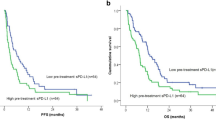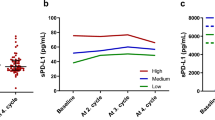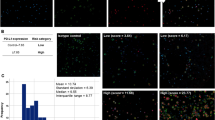Abstract
The dosage of soluble programmed cell death ligand 1 (sPD-L1) protein in the blood of adults with cancer has never been performed in a prospective patient cohort. We evaluated the clinical impact of sPD-L1 level measured at the time of diagnosis for newly diagnosed diffuse large B-cell lymphoma (DLBCL). Soluble PD-L1 was measured in the plasma of 288 patients enrolled in a multicenter, randomized phase III trial that compared R-high-dose chemotherapy with R-CHOP. The median follow-up was 41.4 months. A cutoff of 1.52 ng/ml of PD-L1 level was determined and related to overall survival (OS). Patients with elevated sPD-L1 experienced a poorer prognosis with a 3-year OS of 76% versus 89% (P<0.001). Considering clinical characteristics, the multivariate analysis retained this biomarker besides bone marrow involvement and abnormal lymphocyte–monocyte score as independently related to poor outcome. sPD-L1 was detectable in the plasma and not in the serum, found elevated in patients at diagnosis compared with healthy subjects and its level dropped back to normal value after CR. The intention-to-treat analysis showed that elevated sPD-L1 was associated with a poorer prognosis for patients randomized within the R-CHOP arm (P<0.001). Plasma PD-L1 protein is a potent predicting biomarker in DLBCL and may indicate usefulness of alternative therapeutic strategies using PD-1 axis inhibitors.
This is a preview of subscription content, access via your institution
Access options
Subscribe to this journal
Receive 12 print issues and online access
We are sorry, but there is no personal subscription option available for your country.
Buy this article
- Purchase on SpringerLink
- Instant access to full article PDF
Prices may be subject to local taxes which are calculated during checkout




Similar content being viewed by others
References
De Paepe P, De Wolf-Peeters C . Diffuse large B-cell lymphoma: a heterogeneous group of non-Hodgkin lymphomas comprising several distinct clinicopathological entities. Leukemia 2007; 21: 37–43.
Lenz G, Staudt LM . Aggressive lymphomas. N Engl J Med 2010; 362: 1417–1429.
Chambers CA, Kuhns MS, Egen JG, Allison JP . CTLA-4-mediated inhibition in regulation of T cell responses: mechanisms and manipulation in tumor immunotherapy. Annu Rev Immunol 2001; 19: 565–594.
Waterhouse P, Penninger JM, Timms E, Wakeham A, Shahinian A, Lee KP et al. Lymphoproliferative disorders with early lethality in mice deficient in Ctla-4. Science 1995; 270: 985–988.
Brahmer JR, Tykodi SS, Chow LQ, Hwu WJ, Topalian SL, Hwu P et al. Safety and activity of anti-PD-L1 antibody in patients with advanced cancer. N Engl J Med 2012; 366: 2455–2465.
Hodi FS, O'Day SJ, McDermott DF, Weber RW, Sosman JA, Haanen JB et al. Improved survival with ipilimumab in patients with metastatic melanoma. N Engl J Med 2010; 363: 711–723.
Topalian SL, Hodi FS, Brahmer JR, Gettinger SN, Smith DC, McDermott DF et al. Safety, activity, and immune correlates of anti-PD-1 antibody in cancer. N Engl J Med 2012; 366: 2443–2454.
Wolchok JD, Kluger H, Callahan MK, Postow MA, Rizvi NA, Lesokhin AM et al. Nivolumab plus ipilimumab in advanced melanoma. N Engl J Med 2013; 369: 122–133.
Atanackovic D, Luetkens T, Kroger N . Coinhibitory molecule PD-1 as a potential _target for the immunotherapy of multiple myeloma. Leukemia 2014; 28: 993–1000.
Rosenwald A, Wright G, Leroy K, Yu X, Gaulard P, Gascoyne RD et al. Molecular diagnosis of primary mediastinal B cell lymphoma identifies a clinically favorable subgroup of diffuse large B cell lymphoma related to Hodgkin lymphoma. J Exp Med 2003; 198: 851–862.
Xerri L, Chetaille B, Serriari N, Attias C, Guillaume Y, Arnoulet C et al. Programmed death 1 is a marker of angioimmunoblastic T-cell lymphoma and B-cell small lymphocytic lymphoma/chronic lymphocytic leukemia. Hum Pathol 2008; 39: 1050–1058.
Milpied N, Deconinck E, Gaillard F, Delwail V, Foussard C, Berthou C et al. Initial treatment of aggressive lymphoma with high-dose chemotherapy and autologous stem-cell support. N Engl J Med 2004; 350: 1287–1295.
Fitoussi O, Belhadj K, Mounier N, Parrens M, Tilly H, Salles G et al. Survival impact of rituximab combined with ACVBP and upfront consolidation autotransplantation in high-risk diffuse large B-cell lymphoma for GELA. Haematologica 2011; 96: 1136–1143.
Johnson NA, Slack GW, Savage KJ, Connors JM, Ben-Neriah S, Rogic S et al. Concurrent expression of MYC and BCL2 in diffuse large B-cell lymphoma treated with rituximab plus cyclophosphamide, doxorubicin, vincristine, and prednisone. J Clin Oncol 2012; 30: 3452–3459.
Hans CP, Weisenburger DD, Greiner TC, Gascoyne RD, Delabie J, Ott G et al. Confirmation of the molecular classification of diffuse large B-cell lymphoma by immunohistochemistry using a tissue microarray. Blood 2004; 103: 275–282.
Wilcox RA, Ristow K, Habermann TM, Inwards DJ, Micallef IN, Johnston PB et al. The absolute monocyte and lymphocyte prognostic score predicts survival and identifies high-risk patients in diffuse large-B-cell lymphoma. Leukemia 2011; 25: 1502–1509.
Hothorn T . On the exact distribution of maximally selected rank statistics. Comput Stat Data An 2003; 43: 121–137.
Bland JM, Altman DG . Statistical methods for assessing agreement between two methods of clinical measurement. Lancet 1986; 1: 307–310.
Team RDC. R: A Language and Environment for Statistical Computing. R Foundation for Statistical Computing: Vienna, Austria, 2012.
Stiff PJ, Unger JM, Cook JR, Constine LS, Couban S, Stewart DA et al. Autologous transplantation as consolidation for aggressive non-Hodgkin's lymphoma. N Engl J Med 2013; 369: 1681–1690.
Sehn LH, Scott DW, Chhanabhai M, Berry B, Ruskova A, Berkahn L et al. Impact of concordant and discordant bone marrow involvement on outcome in diffuse large B-cell lymphoma treated with R-CHOP. J Clin Oncol 2011; 29: 1452–1457.
Chen Y, Wang Q, Shi B, Xu P, Hu Z, Bai L et al. Development of a sandwich ELISA for evaluating soluble PD-L1 (CD274) in human sera of different ages as well as supernatants of PD-L1+ cell lines. Cytokine 2011; 56: 231–238.
Frigola X, Inman BA, Lohse CM, Krco CJ, Cheville JC, Thompson RH et al. Identification of a soluble form of B7-H1 that retains immunosuppressive activity and is associated with aggressive renal cell carcinoma. Clin Cancer Res 2011; 17: 1915–1923.
Dossus L, Becker S, Achaintre D, Kaaks R, Rinaldi S . Validity of multiplex-based assays for cytokine measurements in serum and plasma from ‘non-diseased’ subjects: comparison with ELISA. J Immunol Methods 2009; 350: 125–132.
Keustermans GC, Hoeks SB, Meerding JM, Prakken BJ, de Jager W . Cytokine assays: an assessment of the preparation and treatment of blood and tissue samples. J Immunol Methods 2013; 61: 10–17.
Curiel TJ, Wei S, Dong H, Alvarez X, Cheng P, Mottram P et al. Blockade of B7-H1 improves myeloid dendritic cell-mediated antitumor immunity. Nat Med 2003; 9: 562–567.
Dong H, Strome SE, Salomao DR, Tamura H, Hirano F, Flies DB et al. Tumor-associated B7-H1 promotes T-cell apoptosis: a potential mechanism of immune evasion. Nat Med 2002; 8: 793–800.
Wolfle SJ, Strebovsky J, Bartz H, Sahr A, Arnold C, Kaiser C et al. PD-L1 expression on tolerogenic APCs is controlled by STAT-3. Eur J Immunol 2011; 41: 413–424.
Keir ME, Butte MJ, Freeman GJ, Sharpe AH . PD-1 and its ligands in tolerance and immunity. Annu Rev Immunol 2008; 26: 677–704.
Martelli M, Ferreri AJ, Agostinelli C, Di Rocco A, Pfreundschuh M, Pileri SA . Diffuse large B-cell lymphoma. Crit Rev Oncol Hematol 2013; 87: 146–171.
Alizadeh AA, Eisen MB, Davis RE, Ma C, Lossos IS, Rosenwald A et al. Distinct types of diffuse large B-cell lymphoma identified by gene expression profiling. Nature 2000; 403: 503–511.
Rosenwald A, Wright G, Chan WC, Connors JM, Campo E, Fisher RI et al. The use of molecular profiling to predict survival after chemotherapy for diffuse large-B-cell lymphoma. N Engl J Med 2002; 346: 1937–1947.
Castillo JJ, Beltran BE, Song MK, Ilic I, Leppa S, Nurmi H et al. The Hans algorithm is not prognostic in patients with diffuse large B-cell lymphoma treated with R-CHOP. Leuk Res 2012; 36: 413–417.
de Jong D, Xie W, Rosenwald A, Chhanabhai M, Gaulard P, Klapper W et al. Immunohistochemical prognostic markers in diffuse large B-cell lymphoma: validation of tissue microarray as a prerequisite for broad clinical applications (a study from the Lunenburg Lymphoma Biomarker Consortium). J Clin Pathol 2009; 62: 128–138.
Cunningham D, Hawkes EA, Jack A, Qian W, Smith P, Mouncey P et al. Rituximab plus cyclophosphamide, doxorubicin, vincristine, and prednisolone in patients with newly diagnosed diffuse large B-cell non-Hodgkin lymphoma: a phase 3 comparison of dose intensification with 14-day versus 21-day cycles. Lancet 2013; 381: 1817–1826.
Mounier N, Briere J, Gisselbrecht C, Emile JF, Lederlin P, Sebban C et al. Rituximab plus CHOP (R-CHOP) overcomes bcl-2–associated resistance to chemotherapy in elderly patients with diffuse large B-cell lymphoma (DLBCL). Blood 2003; 101: 4279–4284.
Acknowledgements
This study is supported by the French Health Minister (PHRC2007), the National Institute of Cancer (INCa Translational 2010), GOELAMS, a grant from Roche SAS, France and The European Regional Development Fund (ERDF) 2007–2013. We are indebted to Jean-Jacques Sotto, MD for his support to this project; Imane Azzaoui, Pauline Migaud and Emilie Gougeon for the technical assistance; Roselyne Delepine and Marie-Christine Béné for their efforts in gathering the clinical data; Stéphane Natur for setting the cohorts, the research assistants of the GOELAMS for reviewing the source data; Sami Boussetta for the statistical analysis of the independent cohort; the LYSA pathology platform (Hopital Henri Mondor, Créteil) for immunohistochemical and FISH experiments on paraffin embedded tissue block; the Centre de Ressources Biologiques (CRB)—Santé of the Rennes hospital for providing high quality samples. This work was partly supported by a French National Cancer Institute post-doctoral fellowship (grant number PDOC-RC-GO/07-003] to the first author. In 2012, The Groupe Ouest-Est des Leucémies et des Autres Maladies du Sang (GOELAMS) and The Groupe d’Etude des Lymphomes de l’Adulte (GELA) merged to form the Lymphoma Study Association (LYSA).
Author information
Authors and Affiliations
Consortia
Corresponding author
Ethics declarations
Competing interests
The authors declare no conflict of interest.
Additional information
The Groupe Ouest-Est des Leucémies et des Autres Maladies du Sang included the following centers and principal investigators in France: G. Damaj, Centre Hospital-Universitaire, Amiens; A. Clavert, Centre Hospital-Universitaire, Angers; A. Al Jijakli, Centre Hospitalier Départemental, Argenteuil; A. Banos, Centre Hospitalier Départemental, Bayonne; J-L. Dutel, Centre Hospitalier Départemental, Beauvais; E. Deconinck, Centre Hospital-Universitaire, Besançon; P. Rodon, Centre Hospitalier Départemental, Blois; K. Bouabdallah, Centre Hospitalo-Universitaire, Bordeaux-Pessac; P. Soubeyran, CRLCC Bergonié, Bordeaux; B. Choufi, Centre Hospitalier Départemental, Boulogne s/mer; A. Maakaroun, Centre Hospitalier Départemental, Bourges; O. Tournilhac, Centre Hospital-Universitaire, Clermont-Ferrand; J Fleury, Pôle Santé République, Clermont-Ferrand; R. Gressin, Centre Hospital-Universitaire, Grenoble; H. Maisonneuve, Centre Hospitalier Départemental, La Roche Sur Yon; K. Laribi, Centre Hospitalier Departemental, Le Mans; P. Solal-Celigny, Clinique Victor Hugo, Le Mans; P. Moreau, Centre Hospitalier Départemental, Lorient; J.-F. Rossi & G. Cartron, Centre Hospital-Universitaire, Montpellier; N. Morineau, Centre Catherine de Sienne, Nantes; J.L. Harousseau, CRLCC Gauducheau, Nantes; E. Jourdan, Centre Hospitalo-Universitaire, Nimes; M. Alexis, Centre Hospitalier Départemental, Orléans; F. Dreyfus, Hôpital Cochin, Paris; V. Delwail, Centre Hospital-Universitaire, Poitiers; J. Cornillon, Institut de Cancérologie de la Loire, St Priest en Jarez; R. Garidi, Centre Hospitalier Départemental, St Quentin en Yvelines; E. Gyan & P. Colombat, Centre Hospital-Universitaire, Tours; and P. Godemer, Centre Hospitalier Départemental, Vannes.
Supplementary Information accompanies this paper on the Leukemia website
Supplementary information
Rights and permissions
About this article
Cite this article
Rossille, D., Gressier, M., Damotte, D. et al. High level of soluble programmed cell death ligand 1 in blood impacts overall survival in aggressive diffuse large B-Cell lymphoma: results from a French multicenter clinical trial. Leukemia 28, 2367–2375 (2014). https://doi.org/10.1038/leu.2014.137
Received:
Revised:
Accepted:
Published:
Issue Date:
DOI: https://doi.org/10.1038/leu.2014.137
This article is cited by
-
Soluble receptors in cancer: mechanisms, clinical significance, and therapeutic strategies
Experimental & Molecular Medicine (2024)
-
Soluble PD-L1: a potential dynamic predictive biomarker for immunotherapy in patients with proficient mismatch repair colorectal cancer
Journal of Translational Medicine (2023)
-
Association between response to anti-PD-1 treatment and blood soluble PD-L1 and IL-8 changes in patients with NSCLC
Discover Oncology (2023)
-
Prognostic value of soluble programmed cell death ligand-1 (sPD-L1) in lymphoma: a systematic review and meta-analysis
Annals of Hematology (2023)
-
Soluble PD-L1 is a predictive and prognostic biomarker in advanced cancer patients who receive immune checkpoint blockade treatment
Scientific Reports (2021)



